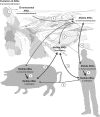Environmental factors influencing the development and spread of antibiotic resistance
- PMID: 29069382
- PMCID: PMC5812547
- DOI: 10.1093/femsre/fux053
Environmental factors influencing the development and spread of antibiotic resistance
Abstract
Antibiotic resistance and its wider implications present us with a growing healthcare crisis. Recent research points to the environment as an important component for the transmission of resistant bacteria and in the emergence of resistant pathogens. However, a deeper understanding of the evolutionary and ecological processes that lead to clinical appearance of resistance genes is still lacking, as is knowledge of environmental dispersal barriers. This calls for better models of how resistance genes evolve, are mobilized, transferred and disseminated in the environment. Here, we attempt to define the ecological and evolutionary environmental factors that contribute to resistance development and transmission. Although mobilization of resistance genes likely occurs continuously, the great majority of such genetic events do not lead to the establishment of novel resistance factors in bacterial populations, unless there is a selection pressure for maintaining them or their fitness costs are negligible. To enable preventative measures it is therefore critical to investigate under what conditions and to what extent environmental selection for resistance takes place. In addition, understanding dispersal barriers is not only key to evaluate risks, but also to prevent resistant pathogens, as well as novel resistance genes, from reaching humans.
Keywords: antimicrobial resistance; dissemination; fitness costs; horizontal gene transfer; human health risks; microbial ecology.
© FEMS 2017.
Figures


References
-
- Allen HK. Antibiotic resistance gene discovery in food-producing animals. Curr Opin Microbiol 2014;19C:25–9. - PubMed
-
- Allen HK, Donato J, Wang HH et al. . Call of the wild: antibiotic resistance genes in natural environments. Nat Rev Microbiol 2010;8:251–9. - PubMed
-
- Allen HK, Moe LA, Rodbumrer J et al. . Functional metagenomics reveals diverse beta-lactamases in a remote Alaskan soil. ISME J 2009;3:243–51. - PubMed
-
- Aminov RI. The role of antibiotics and antibiotic resistance in nature. Environ Microbiol 2009;11:2970–88. - PubMed
-
- Andersson DI. Persistence of antibiotic resistant bacteria. Curr Opin Microbiol 2003;6:452–6. - PubMed
Publication types
MeSH terms
LinkOut - more resources
Full Text Sources
Other Literature Sources
Medical

